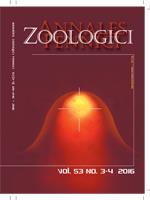The red squirrel (Sciurus vulgaris) is an arboreal species, relatively common in mixed, deciduous and coniferous forests and in urban parks. From autumn to early spring the main diet of red squirrels is seeds in closed conifer cones. In this study, we investigated characteristics of a habitat in western Poland where red squirrels were feeding on Scots pine (Pinus sylvestris). Understory cover, number of tree species, distance to an open area, distance to the nearest great spotted woodpecker (Dendrocopos major) anvil, and size of ten randomly selected Scots pine trees were measured on 70 transects. We used binary logistic regression to test which forest habitat parameters affected the presence of feeding signs of red squirrels. Feeding signs of red squirrels were found from sites close to forest edges with less understory cover, higher tree-species richness and larger size of trees. Red squirrels did not avoid sites close to great spotted woodpecker anvils. We conclude that forest stand structure is important for red squirrel feeding site occurrence, but red squirrels do not avoid close contact to open areas.
How to translate text using browser tools
8 August 2016
Winter Habitat Choice by Foraging the Red Squirrel (Sciurus vulgaris)
Łukasz Dylewski,
Tomasz Przyborowski,
Łukasz Myczko
ACCESS THE FULL ARTICLE

Annales Zoologici Fennici
Vol. 53 • No. 3–4
August 2016
Vol. 53 • No. 3–4
August 2016




